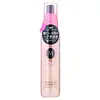What's inside
What's inside
 Key Ingredients
Key Ingredients

 Benefits
Benefits

 Concerns
Concerns

 Ingredients Side-by-side
Ingredients Side-by-side

Water
Skin ConditioningDipropylene Glycol
HumectantGlycerin
HumectantDimethicone
EmollientCetearyl Alcohol
EmollientPEG-60 Hydrogenated Castor Oil
EmulsifyingBehentrimonium Chloride
PreservativeAminopropyl Dimethicone
Lactic Acid
BufferingStearyl Dihydroxypropyldimonium Oligosaccharides
Arginine
MaskingHydroxyethyl Urea
HumectantSteartrimonium Chloride
PreservativeHoney
HumectantSodium Hyaluronate
HumectantHydrolyzed Conchiolin Protein
Skin ConditioningCetyl Ethylhexanoate
EmollientIsopropyl Alcohol
SolventStearyl Pg-Dimethylamine
Isoceteth-10
EmulsifyingPropylene Glycol
HumectantStearyl Alcohol
EmollientDisodium EDTA
Ammonium Lactate
BufferingButylene Glycol
HumectantSodium Carbonate
BufferingWater, Dipropylene Glycol, Glycerin, Dimethicone, Cetearyl Alcohol, PEG-60 Hydrogenated Castor Oil, Behentrimonium Chloride, Aminopropyl Dimethicone, Lactic Acid, Stearyl Dihydroxypropyldimonium Oligosaccharides, Arginine, Hydroxyethyl Urea, Steartrimonium Chloride, Honey, Sodium Hyaluronate, Hydrolyzed Conchiolin Protein, Cetyl Ethylhexanoate, Isopropyl Alcohol, Stearyl Pg-Dimethylamine, Isoceteth-10, Propylene Glycol, Stearyl Alcohol, Disodium EDTA, Ammonium Lactate, Butylene Glycol, Sodium Carbonate
Water
Skin ConditioningCyclopentasiloxane
EmollientPropylene Glycol
HumectantTriethanolamine
BufferingNiacinamide
SmoothingRicinus Communis Seed Oil
MaskingHydroxypropyl Guar
Emulsion StabilisingHydrolyzed Wheat Protein
Skin ConditioningHydroxycitronellal
PerfumingHydrolyzed Corn Protein
Skin ConditioningHydrolyzed Soy Protein
HumectantHydroxypropyltrimonium Hydrolyzed Wheat Protein
Skin ConditioningPhenoxyethanol
PreservativePEG/PPG-17/18 Dimethicone
EmulsifyingBehentrimonium Chloride
PreservativeTrideceth-6
EmulsifyingPolyquaternium-4
Dimethiconol
EmollientLimonene
PerfumingPanthenol
Skin ConditioningBenzyl Salicylate
PerfumingLinalool
PerfumingBenzyl Alcohol
PerfumingAmodimethicone
Isopropyl Alcohol
SolventCaprylyl Glycol
EmollientAlpha-Isomethyl Ionone
PerfumingCarbomer
Emulsion StabilisingGeraniol
PerfumingPotato Starch Modified
Citronellol
PerfumingCetrimonium Chloride
AntimicrobialCoumarin
PerfumingHexyl Cinnamal
PerfumingParfum
MaskingWater, Cyclopentasiloxane, Propylene Glycol, Triethanolamine, Niacinamide, Ricinus Communis Seed Oil, Hydroxypropyl Guar, Hydrolyzed Wheat Protein, Hydroxycitronellal, Hydrolyzed Corn Protein, Hydrolyzed Soy Protein, Hydroxypropyltrimonium Hydrolyzed Wheat Protein, Phenoxyethanol, PEG/PPG-17/18 Dimethicone, Behentrimonium Chloride, Trideceth-6, Polyquaternium-4, Dimethiconol, Limonene, Panthenol, Benzyl Salicylate, Linalool, Benzyl Alcohol, Amodimethicone, Isopropyl Alcohol, Caprylyl Glycol, Alpha-Isomethyl Ionone, Carbomer, Geraniol, Potato Starch Modified, Citronellol, Cetrimonium Chloride, Coumarin, Hexyl Cinnamal, Parfum
 Reviews
Reviews

Alternatives
Ingredients Explained
These ingredients are found in both products.
Ingredients higher up in an ingredient list are typically present in a larger amount.
This ingredient is a preservative and often used for it's anti-static properties. You'll most likely see this ingredient in hair conditioners.
It does not cause irritation or sensitization in leave-on products at 1-5%.
Isopropyl Alcohol is more commonly known as rubbing alcohol. It is most commonly used as a solvent, meaning it helps other ingredients dissolve.
This ingredient is an astringent alcohol. Astringent alcohols may also irritate skin as they high amounts may strip away your skin's natural oils.
Other types of astringent alcohols include:
According to the National Rosacea Society based in the US, you should be mindful of products with these alcohols in the top half of ingredients.
Any type of sanitizing product will have high amounts of alcohol to help kill bacteria and viruses.
Learn more about Isopropyl AlcoholPropylene Glycol is an odorless, colorless liquid. As a humectant, it helps skin retain moisture. It also aids in delivering active ingredients.
Another role of this ingredient is preventing a product from melting or freezing. Propylene glycol also adds antimicrobrial properties to a product, elongating product lifespan.
This ingredient is considered an organic alcohol and commonly added into both cosmetics and foods.
Those with sensitive skin or conditions may develop a rash when using this ingredient.
Learn more about Propylene GlycolWater. It's the most common cosmetic ingredient of all. You'll usually see it at the top of ingredient lists, meaning that it makes up the largest part of the product.
So why is it so popular? Water most often acts as a solvent - this means that it helps dissolve other ingredients into the formulation.
You'll also recognize water as that liquid we all need to stay alive. If you see this, drink a glass of water. Stay hydrated!
Learn more about Water